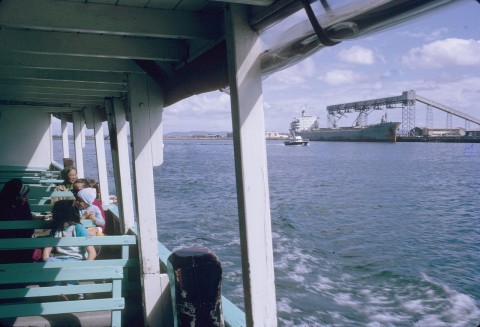Pinkenba, an industrial and residential suburb on the north side of the Brisbane River near its entry to Moreton Bay, is 11 km north-east of Central Brisbane. It is thought that the name was derived from an Aboriginal word referring to a place of tortoises, and it was given to the railway station when the line opened in 1897.
Although situated on low-lying land the Pinkenba district was suitable for grazing and was part of a farm community extending over the present airport land to Cribb Island and Nudgee. A primary school was opened in 1875. Known at first as Boggy Creek School, it was later named Myrtle and finally Pinkenba. Despite the proximity of farms, the area was sufficiently remote from Brisbane for an explosives magazine to be built there. The presence of the magazine together with the Queensland Meat Export works was sufficient incentive for the extension of the railway line from Ascot to Pinkenba in 1897 and the construction of the wharf in 1898.
Pinkenba was the point of embarkation of the Boer War contingent in 1899 and in 1902 a spur line from Pinkenba to the wharf was opened. The line met freight and boat passengers on a separate railway wharf (1909). Pinkenba was also the embarkation point for the 2nd AIF in 1939.
The Post Office directory (1902) recorded the meat works, the explosives magazine, a boarding house, the Myrtle Hotel (1896), a school, two butchers and upwards of 40 farmers at Pinkenba. Numerous farmers were still recorded in the 1949 directory, along with Church of England and Presbyterian churches, the Myrtletown Methodist church, a school of arts, three stores, and a fertiliser works (1946). There was also the Brisbane City Council Sewerage pumping plant, notorious for the collapse of its main sewer in 1940.
Pinkenba's wharf facilities were expanded in 1942, and intensified in the postwar years. Notable events were the construction of the BP refinery on Bulwer Island in the 1960s, cement and clinker plants on Bulwer Island in the next decade, and a line of wharves along Pinkenba for petroleum products (BP and Shell), fertiliser, bulk grain and bulk liquids. Further down-river in Myrteltown, the RAN had a defence station. The heritage-registered remains are in the reserve at the end of Gannon Road.
Meeandah, with a railway station west of Pinkenba, and Myrtletown in the opposite direction, were treated as separate suburbs but are now localities in Pinkenba.
Pinkenba's residential area is a few compact streets north-west of the railway station. It has a few shops and the Pinkenba Hotel, but after its primary school's enrolments fell to six students at the end of 2008 the school was mothballed and then formally closed at the end of 2010. The war memorial in Eagle Farm Road near the hotel is listed on the Queensland heritage register. The census populations have been:
| Census Date | Population |
|---|---|
| 1911 | 366 |
| 1921 | 578 |
| 1976 | 606 |
| 1991 | 414 |
| 2001 | 361 |
| 2006 | 343 |
| 2011 | 350 |
Jennifer Munro, Fighting turtles: the life and times of the children who have attended Pinkenba State School No. 200, Pinkenba, Pinkenba State School, 2002

